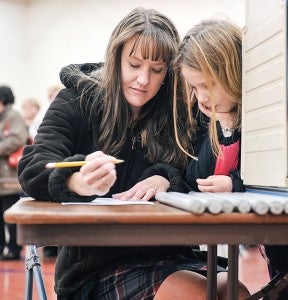Austin decides
Published 11:31 am Tuesday, November 6, 2012

Connie Nelsen casts her vote shortly after 7 a.m. Tuesday morning in Hastings Gym at Austin High School. Nelsen was Ward 1, Precinct 2’s first voter of the 2012 election. -- Eric Johnson/photodesk@austindailyherald.com
Locals hit the polls as Election Day fires up
The election season whittles down to its final moments today as Austin residents distill months of attack ads, debates and yard signs into a final decision at the polls.
Minnesota voters will cast their ballots on local, state and national offices, plus the state’s constitutional amendments on voter ID and the definition of marriage. All polls close at 8 p.m.

Liz Kellner fills out her ballot as her 8-year-old daughter Piper Kellner watches. -- Eric Johnson/photodesk@austindailyherald.com
Eligible voters who have pre-registered will appear in the roster at their polling place. Those who have not can do so at the polls, as long as they provide proper proof of residence. To check registration, view a sample ballot or find the right polling place, visit www.austindailyherald.com/ category/election2012.
This year’s election pits Austin’s incumbent Mayor Tom Stiehm against former City Council member Dick Lang, who runs on the mantra of curbing government spending and limiting tax increases to residents. Stiehm, on the other hand, maintains the level of city spending is necessary for vital services like plowing snow and keeping its streets in good shape.
On a statewide level, Republican candidate Nathan Neitzell takes on incumbent Jeanne Poppe, DFL-Austin, for House District 27B. Neitzell has called for the government to have a hands-off approach and cut regulations on small businesses, while Poppe wants to see the Legislature help out farms and provide subsidies.
Incumbent Dan Sparks, DFL-Austin, competes with Republican candidate Linden Anderson for the Senate District 27 seat. Both candidates promote cutting back on legislative gridlock.
The voter ID amendment, if passed, would require Minnesotans to present a government-issued photo ID to receive a ballot. The marriage amendment would limit marriage to strictly being between one man and one woman.
With both amendments, a “yes” vote would favor making the described change, while voting “no” or not choosing at all would leave the respective system as-is. If the marriage amendment fails, same-sex marriage would not become legal.

